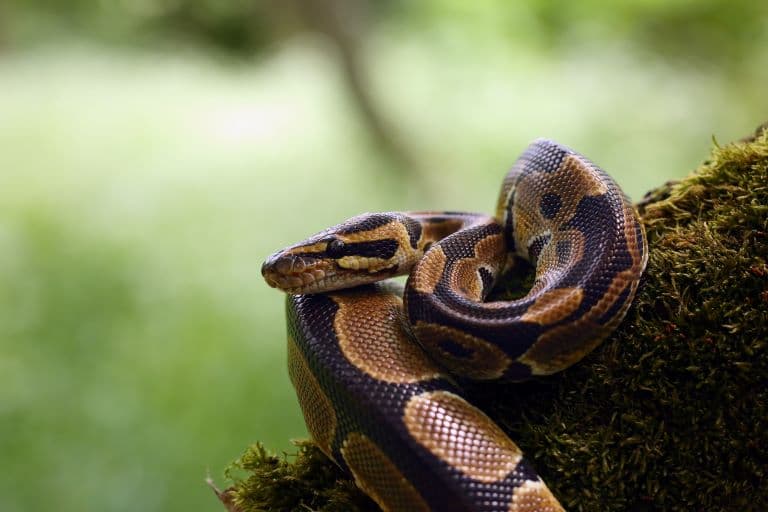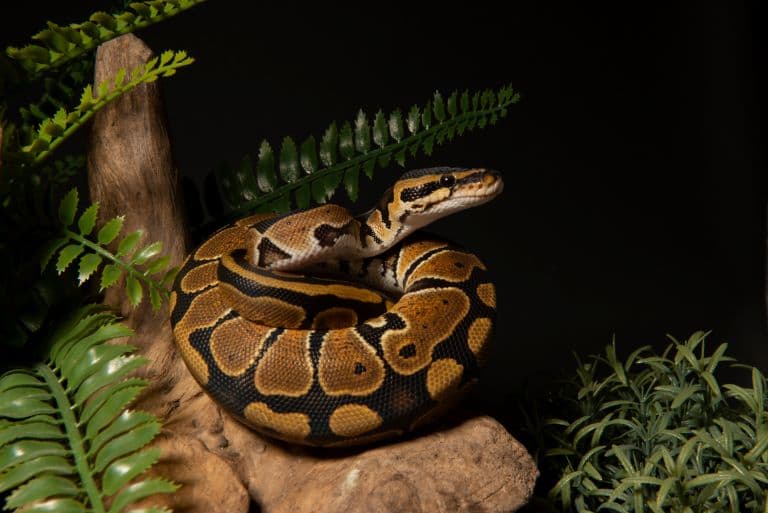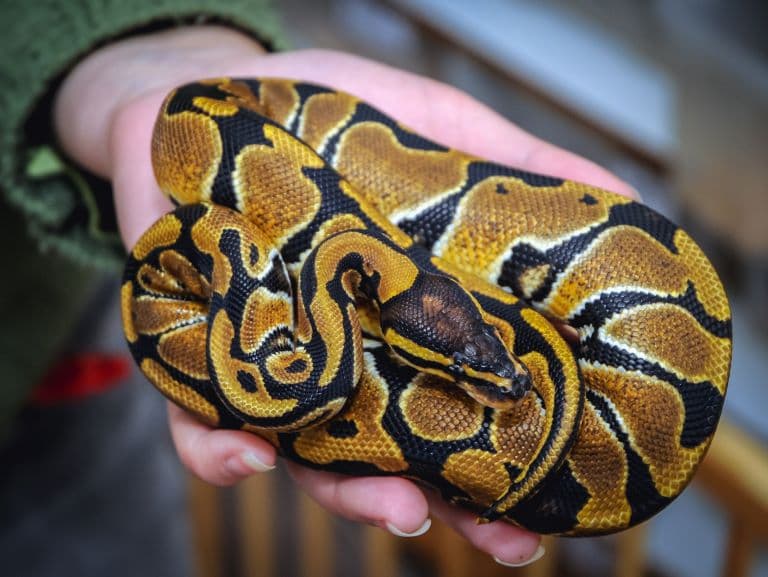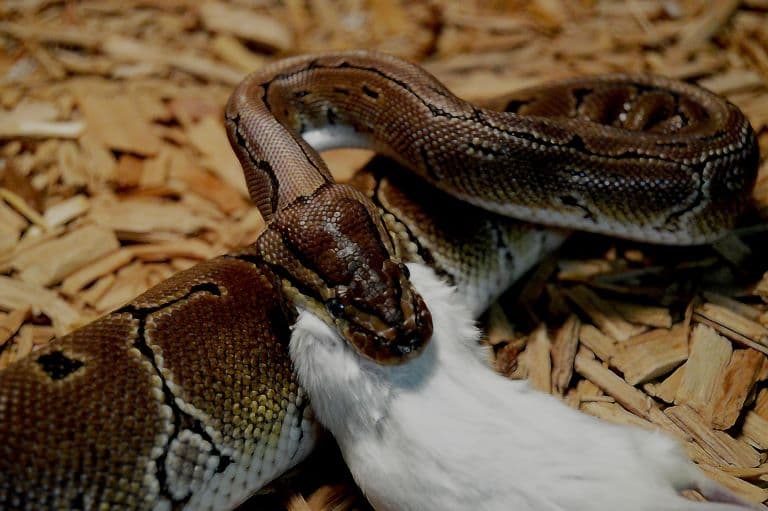Ball Python Profile
In many, if not most, African countries, the sight of a snake is cause for alarm. The fear of snakes runs deep from millions of years of sharing space with some of the most lethal animals on land.
But pythons seem to have a lot of fans, even on the continent, and their popularity has certainly extended far beyond.
Ball pythons, a medium-sized species of true python, are perhaps the most popular reptile in the world.

Ball Python Facts Overview
| Habitat: | Varied, tropical and subtropical, flooded, forested, open grassland/savanna |
| Location: | Western and Central Africa |
| Lifespan: | 10 in the wild, 30 (Possibly 50) in captivity |
| Size: | 1.2m (4ft) long |
| Weight: | Up to 1.7kg (3.7lb) |
| Colour: | Dark, with lighter brown patches down the body |
| Diet: | Rodents and birds |
| Predators: | Possibly black cobras, humans |
| Top Speed: | Sluggish |
| No. of Species: | 1 |
| Conservation Status: | Near Threatened (IUCN) |
Ball pythons are true pythons in a genus with nine other species. They live just South of the Sahara and are named for balling up in defence. They’re almost entirely harmless to humans, having no venom and not large enough to cause any damage from constriction, and they save humans millions of dollars a year in pest control.
So, the locals in a lot of places have come to associate them with good luck and protection. Sadly, their popularity as pets is seeing their numbers decline.
Interesting Ball Python Facts
1. They’re true pythons
There are ten species of true python recognised if you go by the genus Python. There are quite a lot more in the Pythonidae family which has nine other genera in it, but they’re all primarily found in sub-Saharan Africa, Southeast Asia, and Australia.
The ball python is from a narrow band of Africa that extends from the west coast through central Africa and just touches the westernmost borders of East Africa.
Pythons are non-venomous constrictors and have a long history with the humans who evolved alongside them. They birth live young, like most pythons, and generally leave humans alone. In fact, when confronted, they have a peculiar defence mechanism.
2. They form balls
This snake is named after its defensive posture, in which it will coil into a ball and sit its danger end in the middle, facing out.
Sometimes all you can see is a little nose poking between two muscular loops of snake and it’s totally adorable, and ball pythons will generally do this instead of striking if you pick them up, hoping you’ll get distracted and leave them alone.
These are shy and relatively elusive snakes that can be easily scared into a ball and prefer to be left in burrows. 1

3. They spend a lot of time underground
Ball pythons spend most of their time on or under the ground in burrows. Under the earth, they can avoid much of the heat of the day and hide from any diurnal predators that might want to harm them.
They also go into aestivation (summer dormancy) underground when food is scarce, and come out in the evenings and early mornings to stock up on food. Being of slow metabolism, they don’t need to eat all that often anyway, so the ball python spends much of its life just existing, waiting, sitting in the burrow of its last victim. 2
4. They don’t like to do much else
Aside from hunting and mating, there’s not much reason for a ball python to move. They don’t like to dance or play sports because the energy requirements are too high, so they generally remain stationary for much of their lives.
And these incurious animals also hunt in a lazy fashion, preferring to ambush their prey as it comes to them, rather than actively seeking it out. They use chemical and visual cues to find a good location and will strike hard and fast to catch their prey.
After that comes a big squeeze, during which the hapless victim will be contracted by the powerfully muscular snake until the pressure on its heart is too much and it can no longer push the blood around and stops.
And this strategy works wonders in population control. 3

5. They save money
It’s estimated that local communities in Western and Central benefit economically to the tune of tens of millions of dollars a year just from the free service that ball pythons provide.
These are excellent security guards for agricultural lands, where they can sit and eat the rats that come along to damage crops. It could be said that this is even a symbiotic relationship as the farmers may attract rats in the first place by growing crops. Both species benefit tremendously from this arrangement.
The booming trade in this species unfortunately generally doesn’t impact locals, because they’re not the ones getting the money from it. 4
6. They’re the most popular snake
Ball pythons are one of the most popular exotic pets worldwide. They’re docile, beautiful and easy to care for, and after the bearded dragon, they’re the most popular reptile.
They breed well in captivity, but this has not stopped people from hunting and selling wild-caught individuals, and this is causing problems for local populations. Wild-caught snakes don’t do so well in captivity, as they have grown and adapted to the wild conditions and will often refuse to eat and become very stressed and sick.
7. They’re popular with the Igbo
Their popularity is far from limited to the exotic pet community. It seems as though the ecosystem services this snake provides were not lost on various tribes, including the Igbo from Southern Nigeria.
In many African cultures, there exist “taboos”, or forbidden things, specific to a tribe of region. Examples might be whistling at night, or a certain species of animal that one specific tribe must refrain from killing.
To the Igbo, the ball python is a symbol of the Earth and respected as a member of the community. If one dies, some will even build for it a coffin and give it a burial. And in Ghana, it’s considered a saviour and is a taboo to eat. Legends talk of a ball python that once helped their ancestors cross a river to escape their enemies. 5
Ball Python Fact-File Summary
Scientific Classification
| Kingdom: | Animalia |
| Phylum: | Chordata |
| Class: | Reptilia |
| Order: | Squamata |
| Family: | Pythonidae |
| Genus: | Python |
| Species: | Regius |
Fact Sources & References
- Author Name (Year), “Article Name”, Publication.
- “Ball Python”, Zilla RepYourself.
- “ball python”, Sacramento Zoo.
- “Python regius Ball Python, Royal Python”, Animal Diversity Web.
- Francis Diawuo (2015), “Exploring the African Traditional Belief Systems in Natural Resource Conservation and Management in Ghana”, University for Development Studies, (Wa Campus), Ghana.

